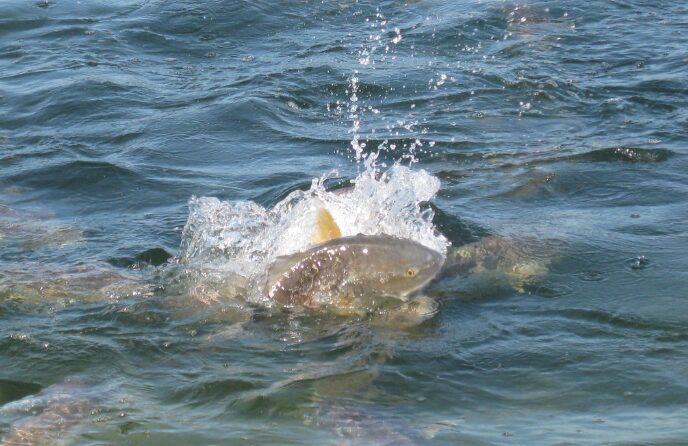Introduction
Drum fishing is an exhilarating sport that challenges anglers to master the art of timing, location, and technique. Whether you’re targeting red drum or black drum, understanding the environmental factors that influence their behavior is key to success. Among the most critical aspects of drum fishing are tides, underwater structures, and seasonal patterns. Each of these elements plays a significant role in where and when drum fish will be feeding. If you want to catch more drum and increase your chances of landing trophy-sized fish, you need to hone your ability to read these natural indicators like a pro. This guide will walk you through the essential drum fishing strategies that every serious angler should know, ensuring that you’re fully prepared for your next fishing adventure.
Understanding Tidal Movements and Their Impact on Drum Fishing
Tides are one of the most important factors influencing drum fishing success. Drum fish are highly dependent on tidal movements for feeding, and understanding how to use tides to your advantage can make all the difference between a slow day and a successful catch.
When the tide is rising, baitfish and crustaceans are carried toward the shallows, making these areas prime spots for feeding drum fish. During a rising tide, anglers should focus on fishing near marsh edges, creek mouths, and estuarine flats where baitfish are being pushed in. Red drum, in particular, love to hunt in these shallow areas as the water level increases.
Conversely, when the tide is falling, bait is flushed out of the shallows and into deeper channels, which becomes a feeding hotspot for drum fish. Black drum tend to congregate in deeper holes and around structure during a falling tide, waiting for the current to bring bait directly to them. Anglers should position themselves in channels or along drop-offs to capitalize on this natural feeding behavior.
Slack tide, which occurs between rising and falling tides, is typically the least productive time to fish. During these periods, the water movement slows down, and drum fish become less active. Instead of wasting time fishing during slack tide, it’s best to use this time to move to a new location, re-rig your setup, or prepare for the next optimal tide phase.
Identifying Key Structure Features That Attract Drum Fish
Structure plays a crucial role in drum fishing. Drum fish are naturally drawn to certain underwater formations that provide food, protection, and ambush opportunities. Knowing how to locate and fish these structures can drastically improve your chances of hooking into a big one.
Oyster beds are one of the top structures to target when drum fishing. These areas attract small fish, shrimp, and crabs, which are a primary food source for both red and black drum. Fishing around oyster beds requires precision and careful casting, as the sharp shells can easily cut your fishing line.
Jetties and rock piles are also excellent locations for drum fishing. These structures create strong currents that trap baitfish and provide a natural feeding zone for drum fish. When fishing near jetties, casting up-current and letting your bait drift naturally can lead to more strikes.
Channels and drop-offs are another essential feature to consider. Drum fish often patrol these areas, using the deeper water as a highway to move between feeding zones. Positioning yourself near a channel bend or drop-off where the current is flowing can result in consistent action.
Lastly, grass flats and submerged vegetation are prime spots for red drum. These areas provide cover for baitfish and allow red drum to hunt stealthily. Sight fishing in these zones can be especially exciting, as you may spot a school of red drum tailing in the shallow water.
Seasonal Drum Fishing Patterns: When and Where to Find Them
Drum fishing success varies throughout the year, and understanding seasonal patterns is crucial for maximizing your catch. Each season presents different challenges and opportunities for anglers.
In the spring, drum fish begin migrating from deeper wintering areas to shallower feeding grounds. This is an excellent time to target them in estuaries, flats, and along shorelines where baitfish are beginning to emerge. Look for warmer waters, as drum fish are more active in slightly elevated temperatures.
Summer offers some of the best drum fishing opportunities, particularly for red drum. During this time, they are highly active and can be found in inlets, grass flats, and along beaches. Night fishing becomes particularly effective in the summer, as drum fish tend to feed more aggressively in cooler nighttime temperatures.
As fall arrives, drum fish begin preparing for winter by feeding heavily. This is often when the largest red drum are caught, as they move into nearshore waters and form large schools. Fishing in deep channels and along structure is highly effective during this season.
Winter can be a challenging season for drum fishing, as drum fish move into deeper holes where the water is warmer. However, slow presentations and using bait such as shrimp or cut crab can still entice bites from sluggish fish. Focus on deep channels and areas with slow-moving currents to find them.
Selecting the Best Bait and Lures Based on Tide and Season
Choosing the right bait and lures for drum fishing can significantly impact your success. Live bait, cut bait, and artificial lures each have their time and place depending on the conditions.
Live shrimp, crabs, and mullet are excellent choices for both red and black drum. During rising tides, free-lining live bait near structure can yield impressive results. When fishing a falling tide, placing live bait on a Carolina rig near channels and drop-offs is highly effective.
Cut bait, such as mullet or menhaden, works exceptionally well for black drum. These fish rely heavily on their sense of smell, making cut bait a perfect choice, particularly in murky waters or during winter months when they are less active.
Artificial lures, including soft plastics and topwater plugs, are ideal for red drum in shallow water. Using lures that mimic baitfish or shrimp can trigger aggressive strikes, especially during summer and fall when red drum are actively feeding.
Expert Tips for Adjusting Your Drum Fishing Tactics in Changing Conditions
Drum fishing conditions can change rapidly, requiring anglers to adapt their strategies on the fly. Here are some expert tips for maximizing your success:
-
-
- Adjust your fishing location based on water clarity. In clear water, use natural-colored lures and live bait. In murky water, opt for scented bait or darker lures for better visibility.
- Modify your retrieval speed and bait presentation according to water temperature. In colder months, slow down your presentation to match the drum fish’s sluggish metabolism.
- Pay attention to wind direction, as it can influence how tides move baitfish. Position yourself accordingly to cast with the natural flow of the current.
-
Conclusion
Drum fishing is both an art and a science, requiring anglers to understand tides, structure, and seasonal behaviors. By mastering these strategies, you can significantly improve your success rate and land more trophy drum fish. Whether you’re a seasoned angler or a beginner looking to up your game, applying these tactics will make every trip more rewarding. Ready to experience the ultimate drum fishing adventure? Call Bill Rixey at Bogue Sound Boats at 252-240-9627 to buy a boat to start your outdoor adventures!


